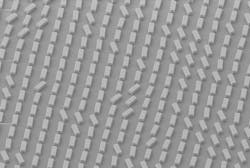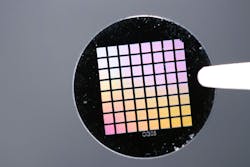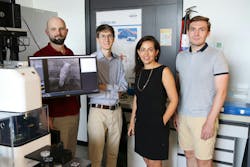Chiral metasurfaces engineered by a team of scientists led by Hatice Altug’s group at the Bionanophotonics Systems Laboratory of the École Polytechnique Fédérale de Lausanne (EPFL) in Switzerland, in collaboration with Yuri Kivshar’s group at the Australian National University (ANU), leverage the interplay between the meta-atom shape and varying the symmetry of its two-dimensional (2D) lattice to easily tune their chirality via polarized light (see video).
The metasurface is crafted from germanium on a calcium difluoride substrate to feature a gradient of meta-atoms with orientations that vary continuously along a chip—and this “control knob” enables seamless tuning of the metasurface’s response to polarized light. In contrast to previous solutions in which very complex chiral meta-atom geometries were used to control the chirality, the team’s new approach makes engineering the chiral response a simple task.
“Our inspiration comes from the fundamental idea of chirality—essentially left- and right-handed materials, which are mirror images of each other that can’t be superimposed,” explains Altug, a full professor at EPFL. “Chirality is pervasive across the living and non-living world, and it plays a fundamental role in biology, chemistry, and materials science. Nature is full of left- and right-handed objects (a.k.a. enantiomers) like our hands or snail shells, which are easy to tell apart.”
But distinguishing left from right can become tricky, “which is fascinating for nanoscale materials,” says Ivan Sinev, a postdoctoral researcher at EPFL. “In living organisms, molecular ‘handedness’ is engraved into the very blueprint of life: the DNA double helix is right-handed in virtually every cell, while the majority of naturally occurring amino acids are left-handed, and most sugars are right-handed. This biological chiral purity is essential—enzymes, receptors, and metabolic pathways are exquisitely enantioselective, so reversing a molecule’s handedness can render a nutrient useless or a drug inactive or even harmful.”
This is where circularly polarized light, which twists like a corkscrew in left- or right-handed spirals as it propagates, comes in handy. It interacts differently with chiral structures, but the effect is generally weak in natural materials, which makes such control difficult.
“Our goal was to develop a simple but powerful way to manipulate light’s ‘handedness’ for advanced optical uses like encryption, sensing, and quantum tech at these tiny scales,” says Ivan Toftul, a Ph.D. student at ANU.
Manipulating light’s chirality
When light is circularly polarized, its electric field rotates as it propagates to form a helical structure. Because left- and right-handed circularly polarized light interact differently with chiral materials, shining a circularly polarized light onto a sample—and comparing how much of each polarization is absorbed, reflected, or delayed—lets scientists probe and read out the sample’s handedness through a phenomenon known as circular dichroism.
And metasurfaces, which are engineered ultrathin 2D lattices of nanosized elements (meta-atoms), can be designed to manipulate light in extremely precise ways. By arranging these meta-atoms with a controlled shape and orientation, optical surfaces can be created that strongly respond to specific light polarizations, which natural materials struggle to achieve.
Encryption, sensing applications ahead
What does the team’s work mean for encryption and sensing? “It demonstrates a way to store and reveal information that’s completely invisible to the human eye within the infrared region of the electromagnetic spectrum,” says Feix Brikh (nee Richter), a Ph.D. student at EPFL. “For example, we created a dual-layer infrared watermark where two different images were encoded on a single metasurface: one was hidden within the distribution of the size of the meta-atoms and decoded using polarized light, while the other was hidden within its orientation and revealed only under circularly polarized light.”
Their approach shows enormous potential for data encryption, anticounterfeiting, biosensing, and quantum tech. “Beyond encryption, our technique can enhance biosensing, since chirality is key to identifying drug composition and purity—critical for distinguishing medicines from toxins,” adds Brikh. “And the ability to manipulate polarization at this level is relevant for quantum technologies, which rely on polarized light for computing tasks.”
Most exciting moments for the team? Successfully encoding two completely different images on the same metasurface and revealing them at different excitation conditions. “Seeing an Australian cockatoo and the Swiss Matterhorn hidden within a single nanostructured chip was an extremely visually appealing validation of our concept,” says Nikita Glebov, a Ph.D. student at EPFL. “Because the images are revealed only for a single wavelength and for a certain polarization, it was thrilling to suddenly see them appear in the experiment when the laser wavelength hits the metasurface resonance.”
Simple, scalable design for strong chiral effects
One major challenge for the scientists—you knew there was one—was to achieve strong chiral effects using a design that remains simple and scalable. “We had to ensure that our metasurface produced a strong and tunable optical effect while still being manufacturable with large-scale nanofabrication technologies. Balancing these design and fabrication constraints was a key technical hurdle,” says Altug.
The team believes their generalized chiral design toolkit offers new ways to control structured light, with potential uses in optical computing, biosensing, chemistry, quantum photonics, and high security encryption. “For real-world use, we need to optimize the fabrication process for larger areas and higher throughput,” Altug says. “With the transition of metasurfaces from research to industry already well underway, we hope to see applications emerging within the next few years.”
FURTHER READING
I. Sinev et al., Nat. Commun., 16, 6091 (2025); https://doi.org/10.1038/s41467-025-61221-2.
About the Author
Sally Cole Johnson
Editor in Chief
Sally Cole Johnson, Laser Focus World’s editor in chief, is a science and technology journalist who specializes in physics and semiconductors.




